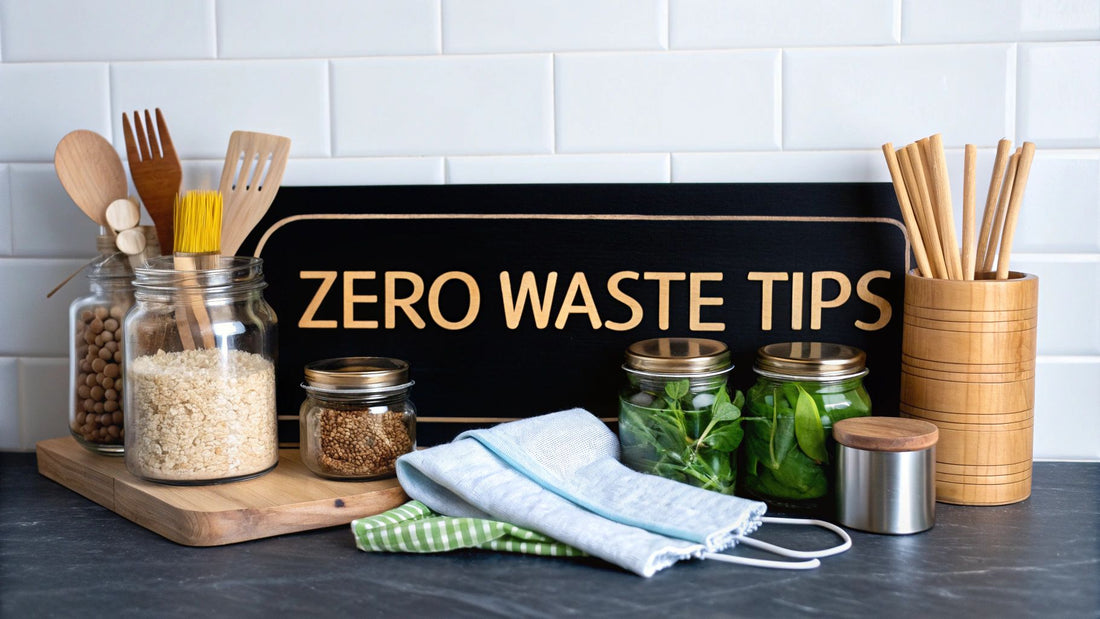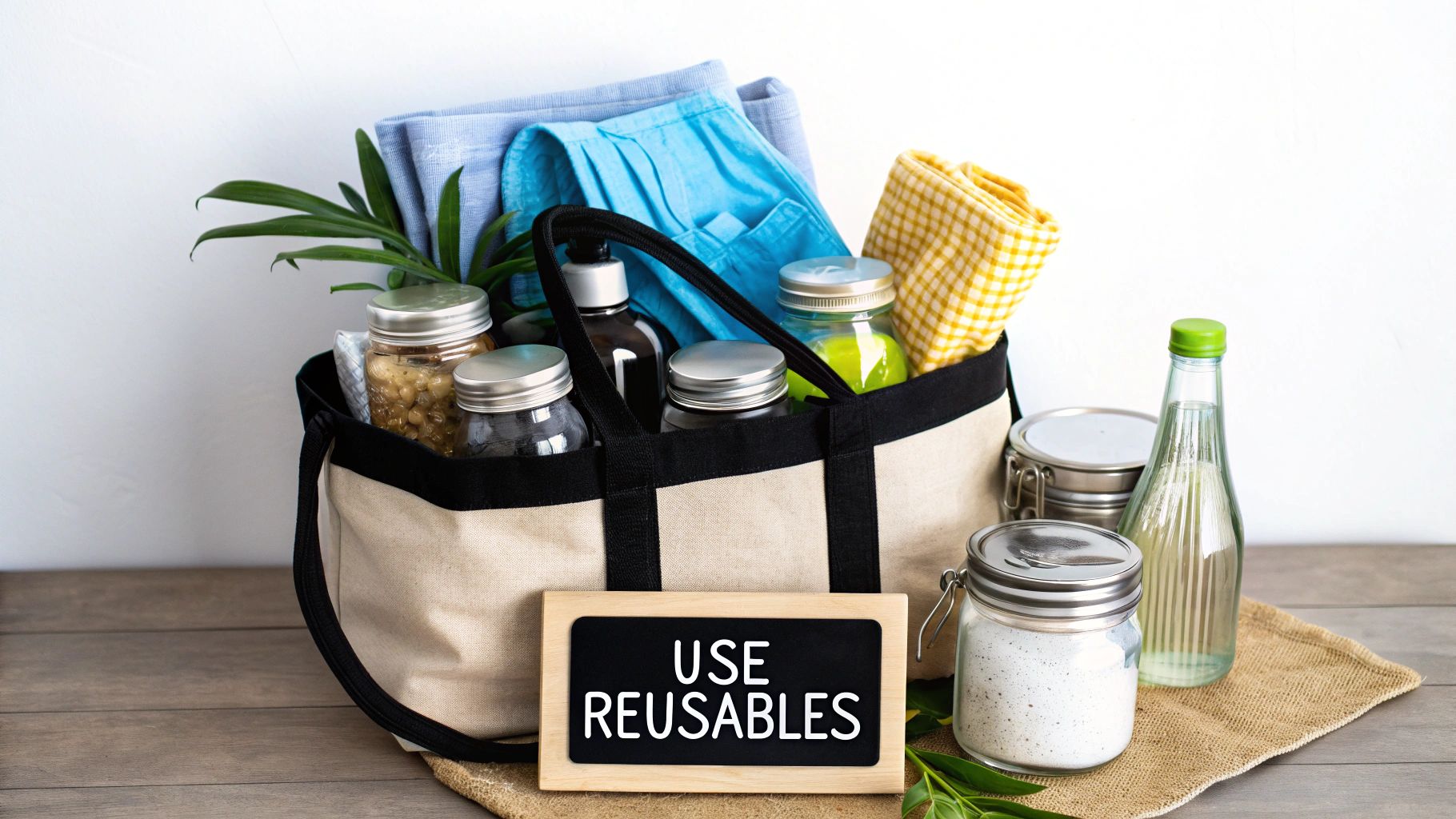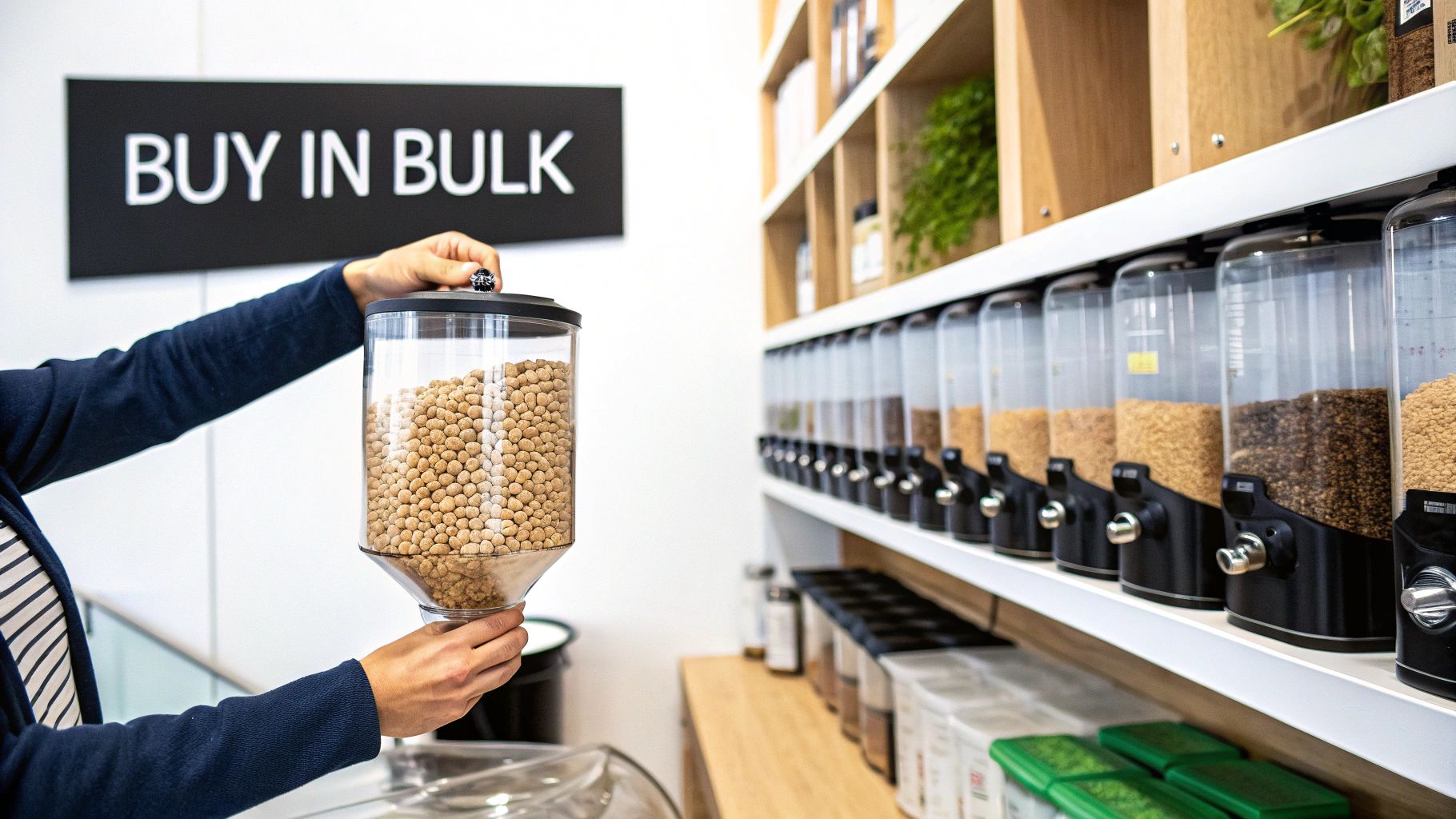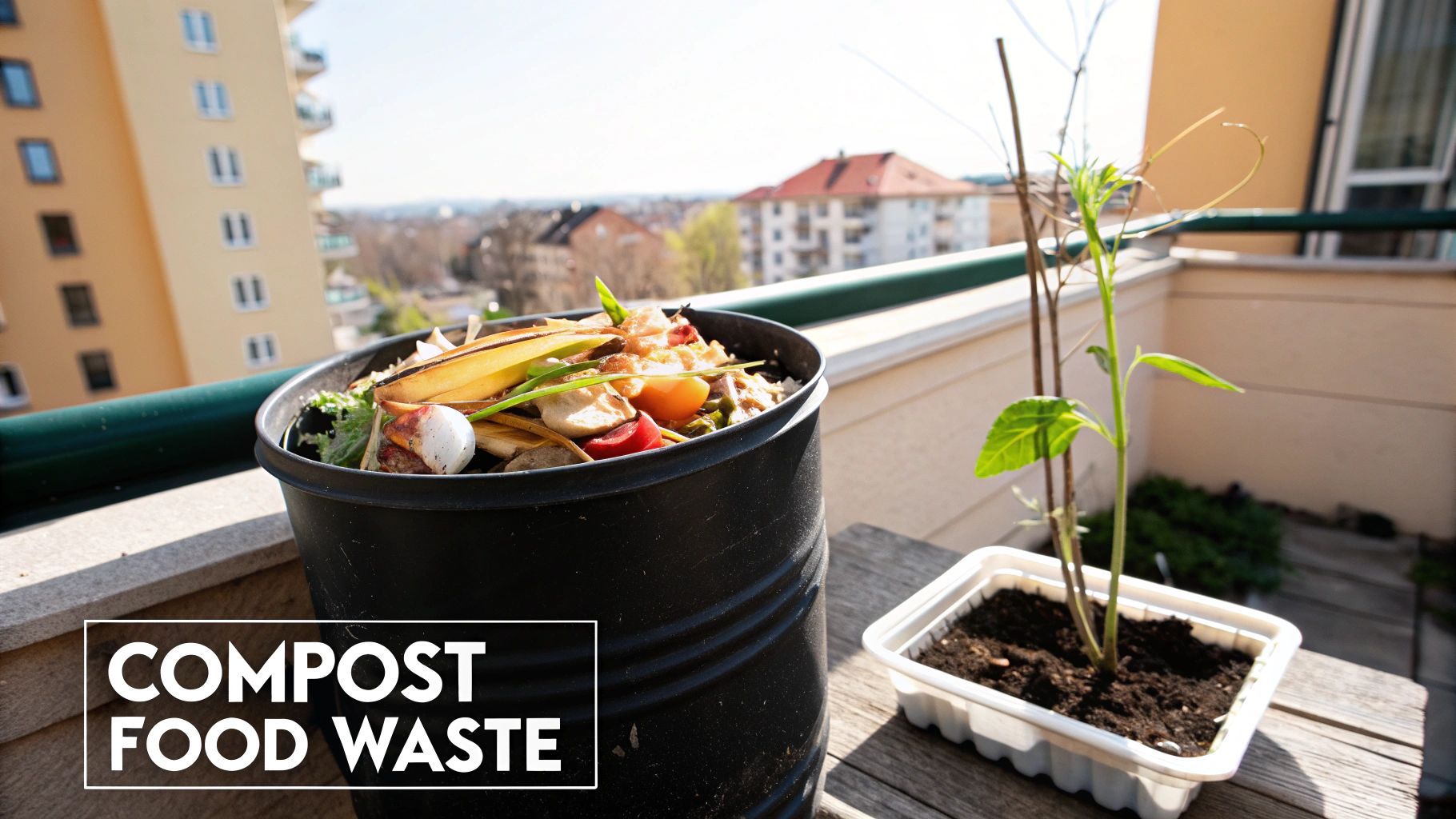
8 Life-Changing Zero Waste Lifestyle Tips for a Healthier Planet in 2025
Share
Imagine a life with less clutter, more savings, and a profound connection to the world around you. This isn't a far-off fantasy; it's the reality a zero waste lifestyle offers. The goal isn't an empty mason jar of trash—it's about making conscious, powerful choices that reclaim your impact on the planet. This is your invitation to a more mindful, fulfilling, and sustainable way of living.
This guide is designed to convince you that a low-waste life is not only achievable but also incredibly rewarding. We've compiled a list of actionable zero waste lifestyle tips that are more than just suggestions; they are gateways to a better future. We'll break down eight powerful strategies—not vague ideals—that you can start implementing today. Each tip is a foundational pillar that will empower you to dramatically reduce your waste, save money, and simplify your daily routine.
This is your roadmap to real change. From rethinking consumer culture to mastering the art of reuse, these insights will prove that you can make a difference, one thoughtful choice at a time. Let's begin.
1. Refuse and Reduce: The Foundational First Step
The journey to a zero waste lifestyle begins not with what you buy, but with what you don't. The principle of "Refuse and Reduce" is the most powerful and proactive step you can take. It’s about consciously preventing waste from entering your life in the first place, shifting your mindset from managing trash to avoiding its creation altogether. This is the cornerstone of the entire zero waste hierarchy, championed by pioneers like Bea Johnson and Lauren Singer, because it stops the problem at its source.
This approach is simpler than it sounds. It means pausing before accepting something and asking, "Do I truly need this?" It’s about being prepared to politely decline things that will ultimately become clutter or waste. By refusing unnecessary items, you send a clear message to businesses about consumer demand, encouraging more sustainable practices.
How to Implement Refuse and Reduce
Putting this principle into action involves building new habits. Start by targeting the most common sources of single-use waste and impulse consumption in your daily routine.
Actionable Steps:
- Practice the Polite "No": Master the phrase, "No, thank you." Say it when offered a plastic bag for a single item, a free pen at a conference, or a plastic straw for your drink. It feels empowering.
- Create a "Wait and See" Rule: For non-essential purchases, enforce a 24 to 48-hour waiting period. This simple delay helps differentiate a genuine need from a fleeting want, saving you money and preventing clutter.
- Arm Yourself with Reusables: The easiest way to refuse single-use items is to have an alternative ready. Always carry a reusable water bottle, coffee cup, and shopping bag.
By embracing this first and most crucial of all zero waste lifestyle tips, you immediately decrease your environmental impact. You simplify your life, save money, and build a foundation of mindful consumption. To dive deeper into specific strategies, explore these tips on how to reduce plastic waste and start making a significant difference today.
2. Embrace Reusable Alternatives
After mastering the art of refusal, the next logical step in your zero waste journey is to replace the disposables you still use with durable, reusable alternatives. This principle is about making intentional, one-time investments in quality items that serve you for years, directly eliminating a continuous stream of single-use trash. It’s a practical and highly effective strategy championed by brands like Klean Kanteen and stores like Life Without Plastic, which have normalized carrying your own gear.

This shift is more than just swapping a plastic bottle for a stainless steel one; it's about building a system of preparedness. By having reliable reusables on hand, you sidestep the convenience trap of disposability. Every time you use your own coffee cup, shopping bag, or container, you are casting a vote for a world with less waste and conserving resources that would have been used to create and transport a throwaway item.
How to Implement Reusable Alternatives
Integrating reusables is about identifying your high-frequency disposable habits and finding a permanent solution. Start small and build a collection of items that seamlessly fit your daily activities.
Actionable Steps:
- Audit Your Trash: Look at what you throw away most often. Is it coffee cups, plastic cutlery, or food wrappers? Target these items first for the biggest impact.
- Create a "Go-Kit": Assemble a small kit with essentials like a set of bamboo utensils, a cloth napkin, and a reusable straw. Keep this kit in your backpack, car, or office desk so you're never caught unprepared.
- Invest in Quality: Choose items made from durable materials like stainless steel, glass, or silicone. A high-quality item may cost more initially but will save you money and resources by lasting for years.
Embracing these alternatives is one of the most visible and satisfying zero waste lifestyle tips. To start your journey, consider upgrading your shopping routine and discover the benefits of eco-friendly shopping bags that can eliminate hundreds of plastic bags from your life.
3. Buy in Bulk and Package-Free
One of the most impactful zero waste lifestyle tips involves changing how you shop, not just what you buy. Buying in bulk and package-free directly tackles the problem of single-use packaging, which clogs landfills and pollutes our oceans. This method involves bringing your own containers to stores and filling them with everything from pantry staples to household cleaners, eliminating the need for disposable bags, boxes, and plastic wrappers.

This practice, championed by pioneers like the Rainbow Grocery Cooperative in San Francisco, puts you in complete control of your consumption. You buy only the amount you need, which reduces food waste and saves money. It transforms grocery shopping from a passive act of grabbing pre-packaged goods into a mindful, intentional process that significantly lowers your environmental footprint.
How to Implement Bulk and Package-Free Shopping
Getting started with bulk shopping is straightforward once you know the basic steps. It requires a little preparation but quickly becomes a simple and satisfying part of your routine.
Actionable Steps:
- Gather and Tare Your Containers: Collect a variety of jars, cloth bags, and bottles. Before filling, weigh each empty container at the store (this is called "taring") so you only pay for the product, not the weight of your container.
- Locate Your Local Bulk Bins: Search for bulk options at local co-ops, health food stores like Natural Grocers, or even larger chains like Whole Foods. Specialty zero waste shops are also becoming more common.
- Start with the Easy Stuff: Don't feel pressured to buy everything in bulk at once. Begin with non-perishable items like rice, oats, nuts, and dried beans. As you get more comfortable, you can expand to spices, oils, and even liquids like shampoo.
Adopting this shopping habit is a powerful way to vote with your wallet, showing retailers a clear demand for less packaging. It’s a practical, cost-effective, and highly effective strategy for anyone serious about pursuing a zero waste lifestyle.
4. Composting and Food Waste Reduction
Tackling food waste is a cornerstone of any effective zero waste lifestyle. Organic materials, like food scraps and yard trimmings, constitute a significant portion of household trash. When this organic matter ends up in a landfill, it decomposes without oxygen, releasing methane, a greenhouse gas far more potent than carbon dioxide. Composting is the natural process of recycling this organic waste into a valuable, nutrient-rich soil amendment called humus.

This powerful practice closes the loop on our food system, returning nutrients to the earth rather than contributing to pollution. By diverting food scraps from the landfill, you directly reduce harmful emissions and create a free, high-quality fertilizer for your garden or houseplants. It is one of the most impactful zero waste lifestyle tips because it transforms a major waste stream into a regenerative resource.
How to Implement Composting and Food Waste Reduction
Getting started with composting is easier than you might think, with options available for every living situation, from large backyards to small apartments. The key is to find the system that works best for you and your space.
Actionable Steps:
- Choose Your Method: For those with outdoor space, a simple backyard bin or a tumbler system is an excellent choice. If you live in an apartment, consider vermicomposting (a worm bin), which is compact and odor-free. Many cities, like San Francisco, also offer municipal composting programs.
- Balance Your Browns and Greens: A healthy compost pile requires a good ratio of carbon-rich "browns" (dried leaves, cardboard, twigs) to nitrogen-rich "greens" (fruit and vegetable scraps, coffee grounds). Aim for a mix that is moist but not soggy.
- Aerate Regularly: Turning your compost pile or tumbling your bin every week or so introduces oxygen, which is crucial for the decomposition process and prevents foul odors from developing.
By adopting a composting practice, you significantly shrink your trash output and take responsibility for your organic waste. To get a comprehensive guide on setting up your system, explore these instructions on how to compost at home and start turning your food scraps into black gold.
5. DIY Natural Cleaning and Personal Care Products
One of the most impactful zero waste lifestyle tips is to take control of what you use on your body and in your home. Making your own cleaning and personal care products is a powerful step that drastically reduces packaging waste and eliminates exposure to harsh chemicals. By using simple, affordable ingredients like vinegar, baking soda, and essential oils, you can replace a cabinet full of plastic bottles with a few effective, multi-purpose solutions.
This approach, championed by resources like the Wellness Mama and Going Zero Waste blogs, returns to traditional, time-tested methods. It empowers you to know exactly what ingredients you are using, avoiding synthetic fragrances and preservatives common in commercial products. This shift not only benefits the planet by cutting down on manufacturing and shipping impacts but also supports a healthier home environment for you and your family.
How to Implement DIY Natural Products
Getting started with DIY recipes is far simpler than it seems. The key is to begin with easy, versatile formulas that require just a few basic ingredients you may already have in your pantry.
Actionable Steps:
- Create a Simple All-Purpose Cleaner: Mix one part white vinegar with one part water in a reusable glass spray bottle. Add a few drops of a citrus or tea tree essential oil for a pleasant scent and extra antibacterial properties.
- Use Baking Soda for Scrubbing: Keep a shaker of baking soda by your kitchen and bathroom sinks. It’s a fantastic non-toxic abrasive for cleaning sinks, tubs, and stovetops without scratching surfaces.
- Try a Minimalist Deodorant: For a simple and surprisingly effective deodorant, mix equal parts coconut oil, baking soda, and arrowroot powder or cornstarch to create a paste. This one recipe can replace countless plastic deodorant tubes over a lifetime.
By embracing this DIY approach, you gain complete control over your consumption, simplify your routines, and significantly reduce your reliance on single-use packaging. To explore more recipes, trusted sources like Wellness Mama offer hundreds of tried-and-true formulas for a healthier, more sustainable home.
6. Repair, Upcycle, and Extend Product Lifespan
In our throwaway culture, it’s often easier to replace a broken item than to fix it. Embracing a zero waste lifestyle means challenging this norm by prioritizing repair and reuse. This principle is about seeing value beyond an item's initial function, fighting planned obsolescence, and keeping resources out of the landfill for as long as possible. Inspired by the "make do and mend" philosophy and modern movements like the Repair Cafe, this approach saves money and deepens your connection to the things you own.
This mindset shift is one of the most impactful zero waste lifestyle tips because it directly combats overconsumption. Instead of immediately looking for a replacement, you first ask, "Can this be fixed? Can it be transformed?" Extending the life of your belongings, even by a few months or years, significantly reduces the environmental cost associated with manufacturing and transporting new goods. It’s a hands-on way to reclaim ownership over your possessions.
How to Implement Repair and Upcycling
Integrating this habit starts with cultivating a bit of curiosity and resourcefulness. You don’t need to be an expert craftsman; you just need a willingness to learn and try.
Actionable Steps:
- Learn Basic Mending Skills: A simple sewing kit can save countless clothes from the bin. Watch online tutorials to learn how to sew on a button, patch a hole in jeans, or darn a sock. These skills are surprisingly easy to pick up.
- Build a Simple Toolkit: Keep essential tools on hand for common household fixes, like a screwdriver set, pliers, and glue. This empowers you to tackle simple repairs on furniture, electronics, and toys without needing to call a professional.
- Embrace Creative Repurposing: Before recycling a glass jar or a worn-out t-shirt, think about its potential. Jars can become stylish storage containers for bulk foods, while old textiles can be cut into cleaning rags, napkins, or even reusable produce bags.
- Visit a Repair Cafe: If a repair is beyond your skill set, look for a local Repair Cafe. These community events, popularized by organizations like RepairCafe.org, connect you with skilled volunteers who can help fix your items for free while teaching you in the process.
7. Shop Secondhand and Support Circular Economy
Embracing the secondhand market is one of the most impactful zero waste lifestyle tips you can adopt. Instead of buying new, you give existing items a second, third, or even fourth life. This practice directly counters the linear "take-make-dispose" model of consumption, which depletes natural resources and creates massive amounts of waste. By choosing used goods, you actively participate in a circular economy, keeping valuable materials in use and out of landfills.
This approach extends far beyond just clothing. You can find secondhand furniture, electronics, books, kitchenware, and home decor. Platforms like the Buy Nothing Project have popularized hyper-local gifting economies, while online marketplaces have made it easier than ever to find exactly what you need pre-loved. Shopping secondhand not only reduces your environmental footprint but also saves you money and allows you to discover unique, high-quality items.
How to Implement Secondhand Shopping
Integrating secondhand shopping into your life requires a slight shift in how you acquire goods. Instead of heading straight to a big-box retailer, you explore local thrift stores, online marketplaces, and community groups first.
Actionable Steps:
- Explore Your Options: Get familiar with local thrift stores like Goodwill, consignment shops, and online platforms such as ThredUp, Poshmark, and Facebook Marketplace. Each offers a different experience and selection.
- Be Patient and Persistent: Secondhand inventory changes constantly. Make a list of items you need and check back regularly. The thrill of the hunt is part of the fun, and patience often leads to finding the perfect item.
- Inspect and Measure: Always check items for quality and condition before buying. For clothing, know your measurements rather than relying on sizes, as they can vary widely between brands and eras. This ensures you buy something you'll actually use.
By making secondhand your first choice, you reduce the demand for new production and all the resources it consumes. This simple change in purchasing habits is a powerful vote for a more sustainable, circular system and a cornerstone of a successful zero waste journey.
8. Mindful Consumption and Intentional Living
A zero waste lifestyle is not just about managing waste; it's about fundamentally changing your relationship with material possessions. Mindful consumption and intentional living form the philosophical core of this shift. This principle involves making deliberate, thoughtful decisions about what we bring into our lives, moving beyond impulse and aligning our consumption with our deepest values. It's an approach popularized by the minimalism movement and Marie Kondo, emphasizing that every item should serve a purpose or bring genuine joy.
This philosophy encourages you to question the true cost of an item, considering its environmental and social impact, not just its price tag. It’s about prioritizing experiences over things and quality over quantity. By adopting this mindset, you naturally reduce waste because you are no longer filling your life with disposable, low-value items that quickly become trash. It is one of the most transformative zero waste lifestyle tips because it addresses the root cause of overconsumption.
How to Practice Mindful Consumption
Integrating this principle requires you to pause and reflect before you act. It’s about cultivating awareness and breaking the cycle of unconscious consumerism. Start with small, consistent habits that challenge your purchasing routines.
Actionable Steps:
- Ask the Right Questions: Before every purchase, stop and ask, "Do I truly need this? Can I borrow it or find it secondhand? Does this align with my values?" This simple pause can prevent countless unnecessary items from entering your home.
- Implement a Waiting Period: For any non-essential purchase, enforce a 30-day rule. If you still feel you need the item after a month, you can reconsider. This effectively separates fleeting wants from genuine needs.
- Prioritize Experiences Over Things: When it comes to gifts or personal spending, shift your focus to creating memories. Choose tickets to a concert, a weekend trip, or a class instead of buying another material object. This enriches your life without creating clutter.
- Focus on Cost-Per-Use: Instead of buying multiple cheap, disposable items, invest in one high-quality, durable alternative. A well-made product will last longer, perform better, and ultimately produce less waste, saving you money in the long run.
Zero Waste Lifestyle Tips: 8-Point Comparison Guide
| Strategy | Implementation Complexity 🔄 | Resource Requirements 🔄 | Expected Outcomes 📊 | Ideal Use Cases 💡 | Key Advantages ⭐ |
|---|---|---|---|---|---|
| Refuse and Reduce | Low to Medium (mindful planning) | Minimal (mainly mindset/practice) | Immediate waste reduction | Everyday consumption, shopping | Most effective waste reduction, saves money long-term |
| Embrace Reusable Alternatives | Medium (must invest and maintain) | Moderate (upfront cost, cleaning) | Significant waste and cost savings | Replacement of single-use items | Durable, reduces single-use dependency |
| Buy in Bulk and Package-Free | Medium (planning and container prep) | Moderate (containers, store access) | Large packaging waste reduction | Dry goods, personal care, groceries | Economical, reduces packaging and food waste |
| Composting and Food Waste Reduction | Medium to High (space and maintenance) | Moderate (compost bins/tools) | Reduces landfill methane, soil enrichment | Organic waste management, gardening | Cuts greenhouse gases, creates valuable compost |
| DIY Natural Cleaning & Personal Care | Medium to High (time and recipes) | Low to Moderate (ingredients/tools) | Eliminates packaging, chemical exposure | Home cleaning & personal care | Cost-effective, multipurpose ingredients |
| Repair, Upcycle, Extend Product Lifespan | Medium to High (skill learning/time) | Low to Moderate (tools/materials) | Waste reduction, extended product life | Damaged or worn items | Saves money, builds skills, reduces landfill waste |
| Shop Secondhand & Support Circular Economy | Low to Medium (time for searching) | Low to Moderate (purchase costs) | Reduces demand for new products | Clothing, furniture, unique/vintage items | Cheaper, reduces environmental impact |
| Mindful Consumption & Intentional Living | Medium (requires discipline) | Minimal (mindset and reflection) | Less clutter, better spending habits | Overall lifestyle, all purchasing decisions | Aligns values with consumption, saves money |
Your Journey to a Zero Waste Lifestyle Starts Now
Embarking on a zero waste journey can feel like a monumental task, but as we've explored, it's not about achieving flawless perfection overnight. Instead, it’s a path built from a series of small, intentional, and powerful choices. The transition to a more sustainable life isn't a race; it's a gradual and rewarding process of unlearning old habits and embracing new, more mindful ones.
You are now equipped with a practical roadmap. We’ve covered everything from the foundational principles of refusing and reducing to the impactful practices of composting, repairing, and shopping secondhand. Each of these zero waste lifestyle tips represents a significant opportunity to reclaim control over your consumption and its environmental footprint. Remember, you don't need to tackle all eight strategies at once. The most powerful change begins with a single, manageable step.
Your First Step: Progress, Not Perfection
The key to lasting change is to avoid feeling overwhelmed. Look back at the strategies we discussed:
- Refusing what you don’t need.
- Embracing reusable alternatives.
- Buying in bulk and package-free.
- Reducing food waste through composting.
- Creating your own DIY products.
- Repairing and upcycling.
- Shopping secondhand.
- Practicing mindful consumption.
Which one resonates most with you right now? Perhaps it's as simple as putting a set of reusable bags in your car so you never forget them. Maybe it's finally setting up that countertop compost bin you've been considering. Or it could be committing to mending a favorite piece of clothing instead of replacing it.
Your journey is unique. The "right" first step is the one you are willing to take today. Every single time you choose a reusable coffee cup, repair a broken item, or compost your kitchen scraps, you cast a vote for a healthier planet.
The Lasting Impact of Your Choices
Adopting these zero waste lifestyle tips extends far beyond just reducing the contents of your trash can. It’s about building a more intentional and fulfilling life. You'll find yourself saving money, eating healthier, and connecting more deeply with your community and the products you use every day. This lifestyle is an empowering act of defiance against a culture of disposability. It proves that individual actions, when multiplied by millions, create a powerful current of change that industries and policymakers cannot ignore.
Your conscious choices contribute to a larger movement that conserves natural resources, reduces pollution, and builds a more sustainable future for everyone. Don’t underestimate the ripple effect of your actions. You have the knowledge, the tools, and the power to make a tangible, positive difference. Choose your starting point, embrace the learning process, and begin your zero waste journey with confidence.
Ready to simplify your transition to a sustainable home? For beautifully designed, effective tools that make reducing waste effortless, explore the starter kits and essentials from terravera. Find your perfect reusable solutions and begin your journey at terravera today.
